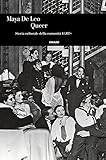I’m happy to have found the following books this year, it’s been a wonderful year for visions and dreams—while most requirements from society faded in the background, it became easier for me to decipher the subtler voices.
Occasional Work and Seven Walks from the Office for Soft Architecture by Lisa Robertson
Maybe the best thing I’ve read this year. Compelling prose on a bunch of places but specific and abstract. Suburbia. Scaffoldings. Imagine the trippiest parts of a DeLillo novel, without the novel. Robertson’s gossamer writing is a convincing argument as to why architecture needs words. But the words should not explain, only build, only connect.
Superstudio’s
The radical architects at Superstudio were great at creating manifestos using collage and language. In a way, they are the Flying Circus of architecture. They did to modern architecture what “the Ministry of Silly Walks” skit did to being adults in a suit.
Sarah Gainsforth‘s “Airbnb Città Merce”
An essay by a very good and relentless Italian communist journalist. It means “Airbnb City Commodity.” Our cities are being emptied out by the Airbnb model. It came out before the pandemic, but it’s still very relevant.
 Elena Croce
Elena Croce ’s Lo snobismo liberale
’s Lo snobismo liberale
The daughter of Italy’s most boring intellectual writes: “The images of “homes”, in those years, seemed to prevail over the images of people… In the notion of “home” people were emphatically acknowledging a fundamental projection of personality. Stating that a person had a “casa simpaticissima” was tantamount to suggesting that said person had secret resources of “intimacy”…”
Maurizio Cattelan: A monography for Riga Review, edited by Elio Grazioli and Bianca Trevisan
Saul Steinberg: A monography for Riga Review, edited by Marco Belpoliti, Gabriele Gimmelli, and Gianluigi Ricuperati
These two quintessentially Milanese characters, one hailing from Romania in the fascist era, one hailing from Padova, both destined to glory in New York, are accounted for in their respective issues of the Riga collection of monographies. They’re both vast and hermetic in their production, they both have a lot to teach on how expression begins where we start to play with our idées reçues and turn them into mysteries.
Jeff Wall‘s Gestus and Lewis Baltz‘s  Scritti
Scritti
Last year I did a podcast on photography with my friend Fabio Severo, a curator and teacher and critic. I wanted to learn more about photography. I also learned that some of photographers are terrific writers, and these are my favorites. Strong opinions, great descriptions of art scenes, and creative riddles.
Fabriano Fabbri
La moda contemporanea II: Arte e stile dagli anni Sessanta alle ultime tendenze
I’ve been looking for great writing on fashion for 10 years. Then an editor at Einaudi who is usually all about the Anthropocene put this mammoth in my hands and now I can read about Pierre Cardin and Virgin Abloh and everything in between and get a clearer idea on the way fashion designers work to change the way we walk.
 Agnès Gayraud’s Dialectic of Pop
Agnès Gayraud’s Dialectic of Pop
More food for thought to declutter the often ham-fisted conversation on pop. Dialectics of Pop is the perfect—and properly gargantuan—treatise for people who swear by Adorno and his disdain for Light Popular Music and also live now and don’t want to live a life of resentment. Pop deserves subtler philosophical ways than hating on it, but you shouldn’t be too smug about it.
 Brian Eno’s A Year with Swollen Appendices
Brian Eno’s A Year with Swollen Appendices
Eno makes life seem important and fluid. The book chronicles a not so important year in his production, I think, which makes his MO of gentle concentration all the more important for us who need better than the egomaniacal, self-conscious irony of the IG/Twitter philosophers.
 Maya De Leo’s Queer. Storia culturale della comunità LGBT+
Maya De Leo’s Queer. Storia culturale della comunità LGBT+
Queer people used to throw costume parties. Then, with the end of the 18th century, identity became the question. De Leo quotes magnificent material from all over the place in the last two centuries, to help us connect with the great travesty/drag of finding one’s identity and respecting the identity of everybody else.
Marco D’Eramo’s  “Dominio”
“Dominio”
A spectacular essay on the way rightwing corporations started subsidizing universities in the late ’70s because they believed that the rich should use the same tactics of communists: hegemony, ideology, ideological guerrilla warfare. The essay is very explicit on the fact that the worst problem for the left is we just blindly make fun of the enemy without ever realizing when its solutions are smart. A real treat for those like me who hate leftist podcasts when all they do is snort and giggle when they mention the enemy.
Charles Burns’s Labirinti
I understand it came out in France first, not yet in the U.S. A genius of grunge comics, he started out making retro stuff and now his grunge ethos of depression and inspiration and impossible love and aliens is both retro and effortlessly emo.
Michele Mari’s Le maestose rovine di Sferopoli
Maybe Italy’s most peculiar writer, the one with the best vocabulary, a heir to Gadda, a stalwart of literature as pastiche and manierismo, Mari has published this collection of short stories that perfectly encapsulate the magic of his vision. One story is mostly made of notes an elementary school teacher takes on his children’s horror stories, that they’ve written as a test. The story combines the very dumb language adults use to judge kids—and the devil.
Gary Indiana’s  Do Everything in the Dark
Do Everything in the Dark
People use the world “bubble” a lot. People swamped in the mainstream have no respect for scenes and call them bubbles. This book is about all the things that make a scene beautiful and gross.
These are the translations I’ve been working on in 2021:
Hanya Yanagihara’s To Paradise
Claudia Rankine’s Just Us
Ralph Ellison’s Juneteenth
Chris Ware’s Building Stories
Yanagihara’s new novel is three novels in one, and there’s a reckless dive into a century of future pandemics that has been weirdly satisfying to translate. And a very classist late 19th-century New York City where gay marriage is legal.
Just Us by Rankine is a thorough, compelling argument about how we are taught by our kindergarten teachers most subtle behavior that black kids are trouble and blonde people are the best. It’s a horror movie in a book of poetic prose.
Juneteenth, Ralph Ellison’s posthumous novel, has maybe the most interesting voice I’ve ever encountered in a novel. I wrote about translating Ellison (I worked on Invisible Man in 2020) on the latest issue of n+1.
Chris Ware’s Building Stories, a collection of printed material about a woman, her family, some buildings, and some bees, all collected in a cardboard case, has been very influential for me. Some structural choices I made on both Class and The Women I Love come straight from this book, and I’m grateful I finally get to do the Italian version.
More from A Year in Reading 2021 (opens in a new tab)
Do you love Year in Reading and the amazing books and arts content that The Millions produces year round? We are asking readers for support to ensure that The Millions can stay vibrant for years to come. Please click here to learn about several simple ways you can support The Millions now.
Don’t miss: A Year in Reading 2020, 2019, 2018, 2017, 2016, 2015, 2014, 2013, 2012, 2011, 2010, 2009, 2008, 2007, 2006, 2005
The post A Year in Reading: Francesco Pacifico appeared first on The Millions.













